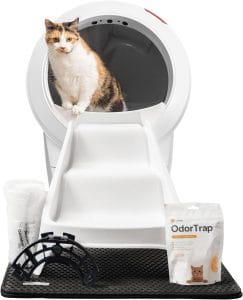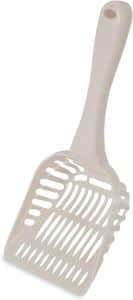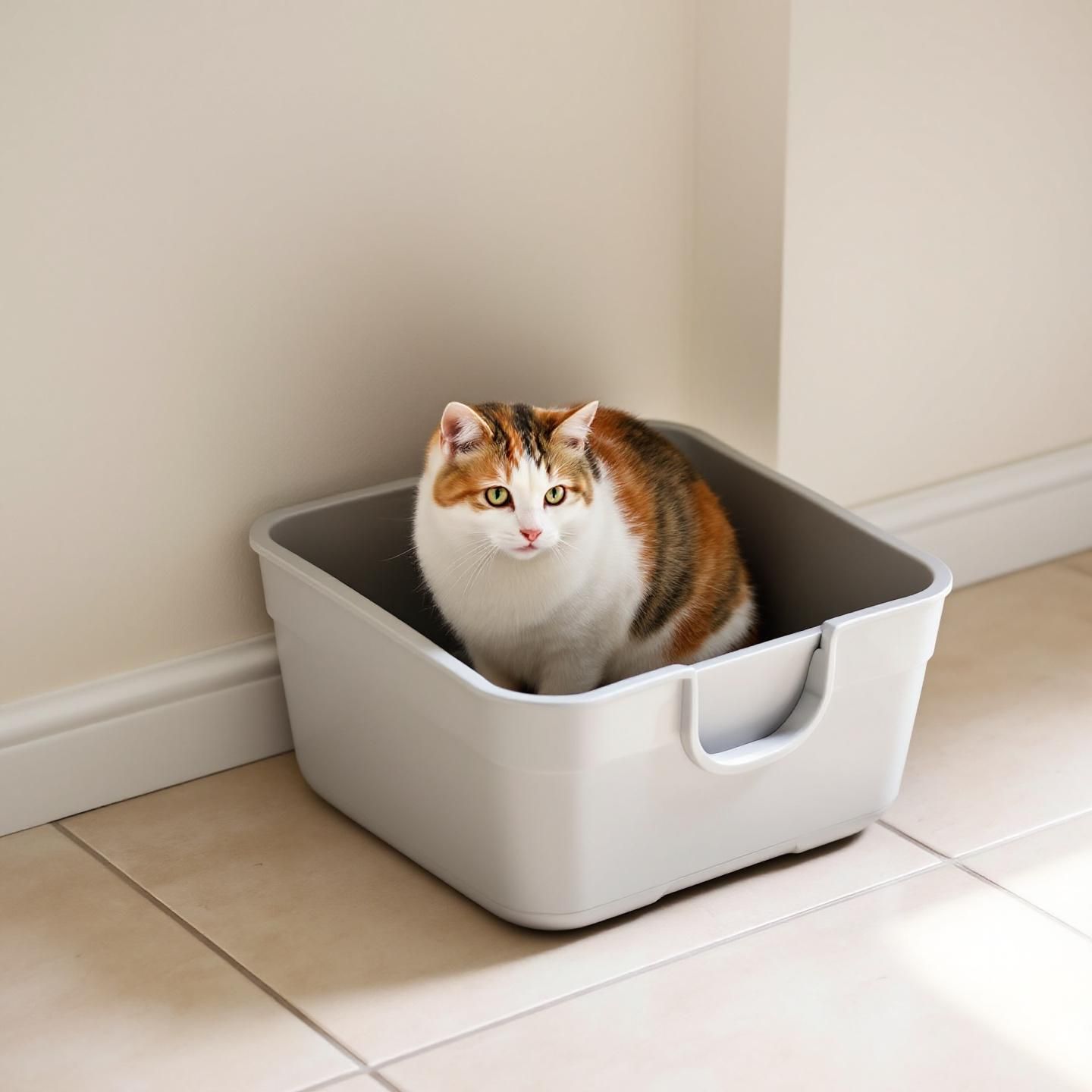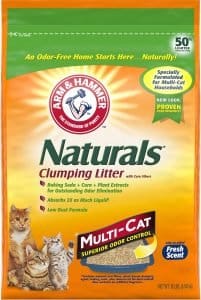Introduction

In this comprehensive guide, we’ll explore the science behind effective litter box setups, drawing on the latest veterinary research and behavioral studies. Whether you’re a new cat parent or looking to resolve ongoing litter box issues, you’ll discover evidence-based strategies to create the ideal bathroom environment for your cat. From selecting the right type of box to determining optimal placement and maintenance routines, we’ll cover everything you need to know to ensure your cat consistently uses their designated bathroom space.
Understanding Your Cat’s Bathroom Preferences
The Evolutionary Perspective
To create the best litter box setup, it helps to understand your cat’s natural instincts. Domestic cats inherited their bathroom behaviors from their desert-dwelling ancestors, who buried waste to avoid detection by predators and to maintain hygiene in their territory.
“Cats are naturally clean animals with strong instincts about waste elimination,” explains Dr. Sarah Johnson, DVM, feline behavior specialist at Cornell University College of Veterinary Medicine. “Their preferences aren’t arbitrary—they’re deeply rooted in evolutionary adaptations that helped their ancestors survive.”
These instincts translate to several key preferences:
- Privacy during elimination
- Clean, unsoiled substrate for digging
- Soft material that allows for burying
- Unobstructed escape routes
- Quiet, low-traffic locations
When designing your litter box setup, accommodating these natural preferences significantly increases the likelihood of consistent use.
Individual Factors That Influence Preferences
While evolutionary instincts provide a foundation, each cat has unique preferences shaped by:
Age: Senior cats may need boxes with lower sides for easier access, while kittens might require smaller boxes initially.
Physical Condition: Cats with arthritis or mobility issues need easily accessible boxes without challenging entry points.
Early Experiences: A cat’s substrate preferences often form during kittenhood, between 3-7 weeks of age, creating lasting preferences for specific textures.
Previous Trauma: Cats who have experienced stress or pain associated with litter boxes may develop avoidance behaviors that require special accommodation.
Dr. Michael Richards, veterinary behaviorist, notes: “Understanding your individual cat’s needs is crucial. What works perfectly for one cat might be completely unacceptable to another, even within the same household.”
Selecting the Right Litter Box
Size Considerations
One of the most common mistakes cat owners make is choosing a box that’s too small. The Journal of Feline Medicine and Surgery recommends that litter boxes should be at least 1.5 times the length of your cat (excluding the tail). This allows your cat to turn around comfortably and dig without stepping outside the box.
For reference:
- Small cats (under 10 pounds): Minimum 16″ x 12″
- Medium cats (10-15 pounds): Minimum 18″ x 14″
- Large cats (over 15 pounds): Minimum 22″ x 18″
Dr. Lisa Pierson, DVM, emphasizes: “Many commercial litter boxes are simply too small for the average adult cat. When forced to use an undersized box, cats often hang over the edges or develop habits of standing with only their front paws in the box.”
Open vs. Covered Boxes
The debate between open and covered litter boxes continues among veterinary professionals, with research suggesting that the best choice depends on individual cat preferences and household situations.
Benefits of open boxes:
- Better ventilation reduces odor buildup inside the box
- Provides visibility to spot approaching threats or other pets
- Easier for owners to monitor elimination habits and health indicators
- More comfortable for larger cats or those with mobility issues
Benefits of covered boxes:
- Provides privacy that some cats prefer
- Contains scatter more effectively
- May be more aesthetically pleasing in living spaces
- Can reduce odor dispersion throughout the home
A 2021 study in the Journal of Veterinary Behavior found that while 70% of owners preferred covered boxes, cats showed no strong overall preference when given the choice between covered and uncovered options. However, individual cats did demonstrate clear personal preferences.
“The best approach is to offer both styles initially and observe which your cat uses more frequently,” recommends Dr. Elizabeth Bales, VMD, feline behavior consultant. “Your cat’s preference should always take priority over aesthetic considerations.”
Self-Cleaning Options: Pros and Cons

Potential benefits:
- Reduces frequency of manual scooping
- Maintains consistently clean litter between uses
- May appeal to extremely fastidious cats
- Helpful for owners with mobility limitations
Potential drawbacks:
- Mechanical noises can frighten sensitive cats
- Movement during or shortly after use may create negative associations
- Higher initial cost and maintenance requirements
- Some models have smaller effective elimination areas
“While self-cleaning boxes can work well for confident cats, those with anxious temperaments often avoid them after being startled by the cleaning mechanism,” explains Dr. Nicholas Dodman, professor emeritus at Tufts University School of Veterinary Medicine. “If introducing an automatic box, keep a traditional option available until you’re certain your cat accepts the new technology.”
Choosing the Right Litter
Types of Cat Litter and Their Properties
The litter market offers numerous options, each with distinct properties that may influence your cat’s bathroom habits:
Clumping Clay Litter
Most popular option (used in approximately 69% of households)
- Forms solid clumps when wet for easy removal
- Excellent odor control
- Typically preferred by cats due to fine texture
- Produces some dust; not biodegradable
Non-Clumping Clay Litter
- More economical than clumping varieties
- Less effective odor control
- Requires full box changes more frequently
- Produces more dust than some alternatives
- Not biodegradable
Silica Crystal Litter
- Superior moisture absorption
- Excellent odor control
- Low tracking around the home
- Longer lasting between changes
- Some cats dislike the texture
Natural/Biodegradable Options
Made from materials like paper, wood, corn, wheat, or walnut shells
- Environmentally friendly and often flushable
- Variable odor control (generally less effective than clay)
- Lower dust production
- May be safer if accidentally ingested
Dr. Gary Norsworthy, board-certified feline specialist, advises: “While owners often focus on odor control and convenience, texture is typically the most important factor for cats. Most prefer fine-grained substrates that allow for digging and covering.”
Depth Matters: How Much Litter to Use
Research indicates that most cats prefer a litter depth of approximately 2-3 inches, which allows for natural digging and burying behaviors without being excessively deep.
“Too little litter prevents cats from covering waste properly, while too much can feel unstable under their paws,” notes Dr. Marty Becker, DVM. “Either extreme can lead to elimination outside the box.”
For clumping litters, maintaining consistent depth is important. As you remove clumps, add fresh litter to maintain the optimal level. For non-clumping varieties, you may need to stir the litter daily to distribute moisture and extend the time between complete changes.
Scented vs. Unscented: What Science Says
While scented litters appeal to human sensibilities, veterinary behaviorists consistently recommend unscented options. A cat’s sense of smell is approximately 14 times more sensitive than a human’s, making artificial fragrances potentially overwhelming or aversive.
A 2018 study published in Applied Animal Behaviour Science found that when given a choice, 86% of cats preferred unscented litter over scented varieties. The research suggested that while humans appreciate masking odors, cats often find artificial fragrances repellent.
“If odor control is a concern, focus on frequent scooping and strategic box placement rather than scented products,” recommends Dr. Ilona Rodan, past president of the American Association of Feline Practitioners. “Air purifiers near litter box areas can also help without introducing scents that might deter your cat.”
Optimal Litter Box Placement
Location Psychology: Where Cats Prefer to Eliminate
Strategic placement significantly influences whether your cat will consistently use their litter box. Behavioral studies indicate that cats prefer locations that offer:
- Privacy: Low-traffic areas away from household hustle and bustle
- Quiet: Minimal noise from appliances, mechanical equipment, or sudden sounds
- Safety: Multiple escape routes and good visibility of approaching threats
- Accessibility: Easy to reach at all times, including when the cat has urgent needs
- Distance from resources: Separated from feeding areas and water sources
“Cats are vulnerable during elimination, so they seek locations where they feel secure,” explains Dr. Meghan Herron, veterinary behaviorist at Ohio State University. “A box placed in a high-traffic area or near unpredictable noise sources creates stress that can lead to avoidance.”
Multi-Cat Households: The N+1 Rule

Importantly, these boxes should not be clustered together. “Multiple boxes in the same location count as one resource in the cat’s mind,” notes Dr. Karen Overall, VMD, PhD, DACVB. “Distribute boxes throughout your home to prevent one cat from controlling access to all elimination areas.”
Research published in the Journal of Feline Medicine and Surgery found that households following the N+1 rule reported 48% fewer inappropriate elimination issues compared to homes with fewer boxes.
Avoiding Common Placement Mistakes
Even well-intentioned cat owners often make placement errors that discourage litter box use:
Placing boxes near loud appliances: Washing machines, dryers, furnaces, or water heaters can create startling noises that frighten cats during elimination.
Locating boxes in high-traffic areas: Hallways, living rooms, or kitchens lack the privacy cats need to feel secure.
Difficult access points: Boxes placed in cabinets with small openings, behind furniture, or requiring cats to navigate obstacles can discourage use, especially for senior or arthritic cats.
Too close to food and water: Cats naturally separate elimination areas from feeding locations. Boxes placed near food or water bowls contradict this instinct.
Limited visibility: Boxes placed in corners or enclosed spaces where cats cannot see approaching people or other pets can create anxiety.
Dr. Sophia Yin, DVM, noted animal behaviorist, advised: “Think of litter box placement from your cat’s perspective—would you feel comfortable and safe using a bathroom in that location? If not, your cat probably won’t either.”
Maintenance and Cleaning Protocols
Scooping Frequency: What Research Recommends

- Daily scooping: At minimum, remove solid waste and clumps once daily
- Twice-daily scooping: Ideal for single-cat households
- Multiple daily scoopings: Recommended for multi-cat households or cats with medical conditions
“Regular scooping is the single most important factor in preventing elimination outside the box,” emphasizes Dr. Tony Buffington, DVM, PhD, DACVN. “Cats are naturally clean animals, and many will refuse to use a soiled box even once.”
Complete Box Changes and Sanitization
Beyond daily scooping, regular deep cleaning helps prevent odor buildup that humans might not detect but cats certainly can:
- Non-clumping litter: Complete replacement every 2-3 days
- Clumping litter: Complete replacement every 2-4 weeks
- Box washing: Coincide with complete litter replacement
- Box replacement: Every 6-12 months (plastic absorbs odors over time)
When washing litter boxes, avoid strong-smelling cleaners or ammonia-based products, which can repel cats or trigger inappropriate elimination. Instead, use mild dish soap and hot water, followed by thorough rinsing and complete drying before adding fresh litter.
“Many commercial cleaning products leave residues that cats find offensive,” warns Dr. Debra Horwitz, veterinary behaviorist. “The goal is to remove odors, not add new scents that might deter your cat.”
Tracking Solutions and Containment Strategies
Litter tracking ranks among cat owners’ top complaints. Effective containment strategies include:
Litter mats: Place textured mats designed to capture litter particles from paws immediately outside the box entrance. Research shows that mats with raised patterns outperform flat surfaces.
High-sided boxes: Boxes with higher walls or top-entry designs can significantly reduce scatter from vigorous digging.
Litter selection: Some litters track less than others, with pellet formulations generally performing better than fine-grained options.
Strategic box placement: Position boxes away from high-traffic areas to minimize the spread of tracked litter throughout the home.
Dr. Carlo Siracusa, clinical assistant professor of animal behavior at the University of Pennsylvania School of Veterinary Medicine, notes: “While tracking is frustrating for owners, solutions should never compromise the cat’s willingness to use the box. If a containment method deters your cat, prioritize their preference over a spotless floor.”
Special Considerations for Different Life Stages
Kittens: Starting Off Right
Kittens require special considerations when establishing litter box habits:
- Lower-sided boxes: Ensure easy access for small kittens
- Consistent litter type: Use the same litter they experienced with their mother or at the shelter
- Multiple box locations: Place boxes in easily accessible areas throughout the home
- Positive reinforcement: Reward litter box use with gentle praise or treats
- Immediate access: Bring kittens to the litter box after meals, naps, and play sessions
“Early positive experiences with litter boxes establish lifelong habits,” explains Dr. Kathryn Primm, DVM. “Most kittens instinctively use litter, but reinforcing this behavior helps prevent problems later.”
Senior Cats: Accommodating Aging Bodies
As cats age, their litter box needs often change:
- Lower entry points: Boxes with at least one very low side accommodate arthritic cats
- Larger boxes: Provide more space for cats with reduced mobility
- More boxes: Place additional boxes throughout the home to reduce travel distance
- Consistent locations: Avoid moving boxes, as senior cats may have difficulty adapting to changes
- Non-slip entry: Ensure stable footing at box entrances
“Many litter box issues in senior cats stem from physical discomfort rather than behavioral problems,” notes Dr. Mary Gardner, co-founder of Lap of Love Veterinary Hospice. “Simple modifications can make a significant difference in their ability to maintain proper elimination habits.”
Medical Conditions That Affect Litter Box Use
Several health conditions can impact a cat’s litter box behavior:
Urinary tract infections: Cause urgency and pain during elimination, potentially creating negative associations with the litter box
Arthritis: Makes climbing into boxes or assuming elimination positions painful
Cognitive dysfunction: Can lead to confusion about litter box location or purpose
Gastrointestinal disorders: May cause urgency that prevents reaching distant litter boxes
Diabetes or kidney disease: Increases urination frequency and volume
Dr. Julie Levy, professor of shelter medicine at the University of Florida College of Veterinary Medicine, emphasizes: “Any sudden change in litter box habits warrants veterinary attention. Treating underlying medical conditions often resolves elimination problems without behavioral intervention.”
Troubleshooting Common Litter Box Problems
When Cats Eliminate Outside the Box
Inappropriate elimination is among the most frustrating challenges cat owners face. Addressing the problem requires identifying the underlying cause:
Medical issues: Always rule out health problems first through veterinary examination
Box aversion: The cat may dislike some aspect of the box itself (type, size, cleanliness)
Substrate aversion: The cat may object to the litter type or depth
Location aversion: The box placement may feel unsafe or uncomfortable
Surface preference: The cat may prefer eliminating on specific textures or materials
Social stress: Multi-pet households may create anxiety around shared resources
Dr. Mikel Delgado, certified cat behavior consultant with a PhD in psychology, recommends: “Document exactly where inappropriate elimination occurs, what surfaces are targeted, and any patterns in timing or circumstances. This information helps pinpoint the specific cause and appropriate solution.”
Retraining Strategies That Actually Work
Evidence-based approaches to resolving litter box issues include:
Attraction techniques: Using feline pheromone products like Feliway near the litter box can increase appeal
Gradual transitions: When changing litter types, mix small amounts of new litter with the old, gradually increasing the proportion
Positive reinforcement: Reward proper litter box use with treats or praise, never punish inappropriate elimination
Environmental modification: Address potential stressors like inter-cat conflict or changes in household routine
Temporary confinement: Restricting the cat to a smaller area with appropriate litter box access can help re-establish habits
“Punishment never works for litter box issues and typically makes the problem worse by increasing stress,” cautions Dr. Amy Marder, VMD, animal behavior specialist. “Focus instead on making the litter box the most attractive elimination option available.”
Innovative Litter Box Solutions for Modern Homes
Space-Saving Designs for Small Living Spaces
For apartment dwellers or those with limited space, several innovative solutions maintain proper litter box function without compromising cat preferences:
Furniture integration: Litter boxes designed to look like end tables or cabinets can blend into living spaces while providing cats with privacy
Corner designs: Triangular boxes maximize space efficiency in small rooms
Stackable systems: For multi-cat households, vertically-oriented options save floor space
Under-bench options: Low-profile boxes that slide under furniture when not in use
Dr. Liz Bales notes: “While space-saving designs can work well, never sacrifice the fundamental requirements of size, accessibility, and cleanliness just to make the box less visible.”
Eco-Friendly Options for Environmentally Conscious Owners
For environmentally-minded cat owners, several sustainable approaches reduce the ecological impact of litter box maintenance:
Biodegradable litters: Options made from recycled paper, wood, corn, or wheat break down naturally
Reusable liners: Washable, waterproof liners reduce plastic waste from disposable options
Composting systems: Some natural litters can be composted (separate from food gardens)
Water-efficient cleaning: Using collected rainwater or greywater for cleaning empty boxes
“Sustainable cat care is increasingly important to many owners,” observes Dr. Justine Lee, DVM, DACVECC. “Fortunately, there are now effective eco-friendly options that don’t compromise your cat’s bathroom preferences.”
Conclusion
Creating the best litter box setup requires understanding your cat’s natural instincts and individual preferences while addressing practical household considerations. By selecting appropriate boxes, litter, and locations—and maintaining consistent cleaning routines—you can prevent most elimination problems before they start.
Remember that your cat’s litter box preferences aren’t arbitrary or designed to frustrate you; they reflect evolutionary adaptations and personal comfort needs. When litter box issues arise, approach them as puzzles to solve rather than behavioral problems to correct, looking for specific causes and tailored solutions.
For most cats, the ideal setup includes appropriately sized boxes with preferred litter in quiet, accessible locations, kept scrupulously clean. By prioritizing these fundamentals over convenience or aesthetics, you’ll create a bathroom environment your cat will reliably use—benefiting both your home’s cleanliness and your relationship with your feline companion.
Frequently Asked Questions
How many litter boxes should I have for multiple cats?
Follow the N+1 rule: provide one more litter box than the number of cats in your household. For example, a three-cat home should have at least four litter boxes. Importantly, distribute these boxes throughout your home rather than grouping them in one location. This prevents resource guarding and ensures each cat always has access to a clean, available option.
Why has my cat suddenly stopped using the litter box?
Sudden changes in litter box habits often indicate medical problems and warrant veterinary attention. Common medical causes include urinary tract infections, bladder inflammation, kidney disease, arthritis, or gastrointestinal issues. If your veterinarian rules out health concerns, consider recent changes to the box, litter, location, or household dynamics that might create stress or aversion.
How often should I completely replace the litter and clean the box?
For clumping litter, completely replace and clean the box every 2-4 weeks, even with regular scooping. Non-clumping litter requires complete replacement every 2-3 days. When cleaning, use mild dish soap and hot water rather than strong-smelling cleaners or ammonia-based products, which can repel cats. Replace plastic litter boxes every 6-12 months, as they absorb odors over time that cats can detect even after thorough cleaning.
What’s the best way to transition my cat to a new type of litter?
Make gradual transitions over 1-2 weeks by mixing increasing amounts of the new litter with the old. Start with 75% old litter and 25% new, then gradually adjust the ratio until you’re using only the new product. This slow transition respects your cat’s sensitivity to change and reduces the likelihood of rejection. If your cat shows any reluctance during the transition, slow down the process or reconsider whether the new litter is appropriate for your cat’s preferences.
How can I reduce litter tracking throughout my home?
Reduce tracking by placing textured litter mats outside box entrances to capture particles from your cat’s paws. Consider litter box styles with higher sides or top entries to contain scatter from digging. Some litter formulations track less than others, with pellet-based products generally performing better than fine-grained options. Strategic box placement away from high-traffic areas also minimizes the spread of tracked litter throughout your home.

 Most popular option (used in approximately 69% of households)
Most popular option (used in approximately 69% of households) Made from materials like paper, wood, corn, wheat, or walnut shells
Made from materials like paper, wood, corn, wheat, or walnut shells


